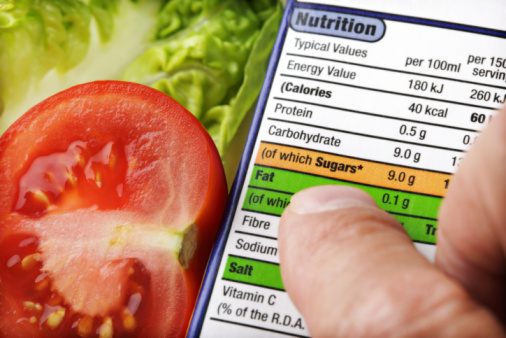Once upon a time, food was fairly self-explanatory. You pretty much knew that a chicken was a chicken, vegetables were vegetables, and there was only one kind of milk to choose from -- the kind that came out of a cow -- unless you happened to prefer the milk of some other mammal.

But these days, things are a little more complicated. How do you really know what goes into a box of cereal? What do all of those impressive-sounding labels really mean?
Below, I’ve broken it down into two categories: claims that food companies make and ingredients you should avoid.
Claims that Food Companies Make:
- Natural or Organic: Natural just means the product does not include synthetic or artificial ingredients. That’s good in the sense that you want to avoid consuming as many chemicals as possible, as many of them have been linked with a number of illnesses (see the list of ingredients to avoid, below). Organic means the food is grown without fertilizers, insecticides, herbicides, or growth hormones according to USDA standards. Sometimes it’s worth it to pay more for organic and sometimes it isn’t, based on how full of pesticides the inorganic food tends to be. In general, you want to buy the “dirty dozen” fruits and veggies organic, and you can save your money on the “clean fifteen” (http://www.ewg.org/foodnews/summary/).
- Lean and Extra Lean: These terms apply to meat, poultry, and fish. Lean means there’s less than 10 grams of fat, 4.5 grams or less of saturated fat, and 95 mg cholesterol per 100 grams. Extra lean means less than 5 gm fat, less than 2 grams saturated fat, and less than 95 mg cholesterol per 100 grams. It’s a good idea to choose lean meats, as they decrease the risk of cancer otherwise associated with other meats. But it’s most important to choose organic and free range meats if at all possible, because free range meats contain a better ratio of omega 3 to omega 6 (decreasing the risk of many inflammatory diseases), and organic meats do not contain growth hormones.
- Enriched and Fortified: Both of these terms mean that vitamins and minerals were added to the food, but fortified means more of the nutrients naturally found in the food were added, while enriched means that vitamins and minerals that were lost during processing were added back. But don’t think that the food itself is healthy just because the company added a few extra nutrients. If a food needs to be enriched in the first place, it’s processed, and processing leads to a number of other problems (see the list of ingredients to avoid, below). Also beware of the high sugar content commonly found in processed foods.
- Heart Healthy: This is a bit of a catch-all term, meaning the food is low in calories, whole grain, fat-free, and/or made with oil instead of saturated fat. The label is usually unregulated though, so you should take it with a grain of salt…no pun intended.
- Low-Fat and Fat-Free: Low-fat means three grams of fat or less per serving size. Fat-free means what it sounds like: only traces of fat exist in the food or none at all. If you choose these foods because you’re trying to lose weight, though, beware that fat-free does not mean low-calorie. In fact, for purposes of weight loss it’s more important to avoid sugar and processed carbohydrates than fat. For more information, see here: http://www.drlaurendeville.com/articles/get-healthy-for-the-new-year/.
- Whole Grain: This means that all three major components of the grain kernel remain in the food: bran, germ, and endosperm. The bran contains fiber and B vitamins, magnesium, phosphorus, iron and zinc. The germ contains Vitamin E, selenium, thiamine, iron, magnesium, phosphorus, zinc, and protein. The endosperm contains protein and carbohydrates.
When grains are milled, they lose the bran and the germ, retaining only the protein and carbs from the endosperm. The lack of fiber in processed grains means that the remaining carbs hit your bloodstream almost immediately, and they act basically just like sugar. Additionally, the loss of the bran and germ removes most of the nutritional value of the grain. So are whole grains a better idea than processed? Emphatically, yes.
- Gluten-Free: Gluten is a protein found in the germ (see above) of wheat, rye, barley, and several other grains. Gluten intolerance and Celiac Disease are both relatively common, and especially for Celiac patients, total gluten avoidance is critical. That said, if you are not gluten sensitive, you don’t really need to avoid it.
Ingredients You Should Avoid:
- Trans Fats, a k a Partially Hydrogenated Oils: Trans fat means that hydrogen has been added to a liquid fatty acid to render it solid at room temperature, increasing its shelf life and improving texture or “mouth feel.” It’s found in margarine, shortening, fried foods, and all kinds of processed foods. Trans fats are incorporated into your cell walls, causing poor cell membrane and receptor function, and they also increase “bad” cholesterol (LDL) and lower “good” cholesterol (HDL). This contributes to a number of chronic diseases, including heart disease and cancer. Trans fats also lower immune system function and increase insulin resistance. Avoid them completely if at all possible.
- Artificial Sweeteners: as a general rule, even though excessive sugar is a bad idea (for more information see here: http://www.drlaurendeville.com/articles/get-healthy-for-the-new-year/), if you must sweeten your food it’s actually better idea to use real sugar than the stuff created in a lab. That’s because these are your main alternatives:
- Saccharin: An artificial sweetener found in Sweet and Low, 30-500 times sweeter than sugar. It’s associated with bladder cancer when fed to rats in large quantities.
- Aspartame: Found in Nutrasweet and Equal. It gets metabolized to excitatory amino acids which can lead to neuron cell death, and has been linked with various neurological diseases such as MS, ALS, and Alzheimer’s Disease. It has also been linked to a number of adverse food reactions including headaches, migraines, depression, seizures, weight gain, irritability, insomnia, joint pain, and memory loss.
- Sucralose: Found in Splenda, which is 600 times sweeter than sugar. Its byproducts are in the same chemical category as certain pesticides (PCBs and DDT), and inconclusive studies suggest that it may cause genetic mutations. High doses have been linked with lower immune function.
- Saccharin: An artificial sweetener found in Sweet and Low, 30-500 times sweeter than sugar. It’s associated with bladder cancer when fed to rats in large quantities.
- Preservatives: Common in processed foods to increase shelf life, these have been associated with allergic reactions and are stored in body fat (which means it’s hard to get rid of them). They include:
- BHA (Butylated hydroxyanisole) and BHT (Butylated hydroxytoluene). These are found in prepared and packaged foods.
- Benzoates: Found in shrimp and fish
- Sulfites: These are sprayed on fruit, veggies, and shrimp and associated with asthma.
- Sodium nitrites and sodium nitrates: These are found on processed meats, and they are a known cause of stomach cancer. They are, however, counteracted by Vitamin C so if you have to have that cured bacon for breakfast, take your vitamins too.
- BHA (Butylated hydroxyanisole) and BHT (Butylated hydroxytoluene). These are found in prepared and packaged foods.
- Monosodium glutamate: Especially common in Chinese food prepared in restaurants, this is added to increase the salty flavor of protein. It is a common cause of allergic reactions including chest tightness, diarrhea, headaches, and flushing. For those who are not allergic it’s not really a problem, other than the fact that foods with additives are probably not the healthiest options.
- Salicylates: These are chemically similar to aspirin, and so people with allergies to aspirin may not tolerate them well. They are found in cake mixes, sodas, dried fruits and berries, gum, pudding, and ice cream, and they are also used to enhance the flavor of certain spices.
- Artificial Dyes: Blue #2 is found in soda and has been associated with brain cancer. Green #3, found in lime drinks and popsicles, has been associated with thyroid cancer. Yellow #6, in soda and candy, has been associated with kidney cancer. Yellow #5 (also called tartrazine) is associated with allergies and ADD, and sensitivity is very common. It is found in orange drinks, cake mixes and icings, seasoning salt, macaroni and cheese, gelatin desserts, and Italian dressings.
The bottom line? Read labels. Avoid sugar, trans fats or partially hydrogenated oils, and any ingredients you don’t recognize. Choose foods that will spoil and eat them before they do. If you follow just these simple rules, you can forget the rest.
Eating healthy really isn’t that hard – most of our ancestors had it figured out. All it takes is a little common sense.
 Dr Lauren Deville is board-certified to practice Naturopathic Medicine. For more information, please see www.drlaurendeville.com.
Dr Lauren Deville is board-certified to practice Naturopathic Medicine. For more information, please see www.drlaurendeville.com.